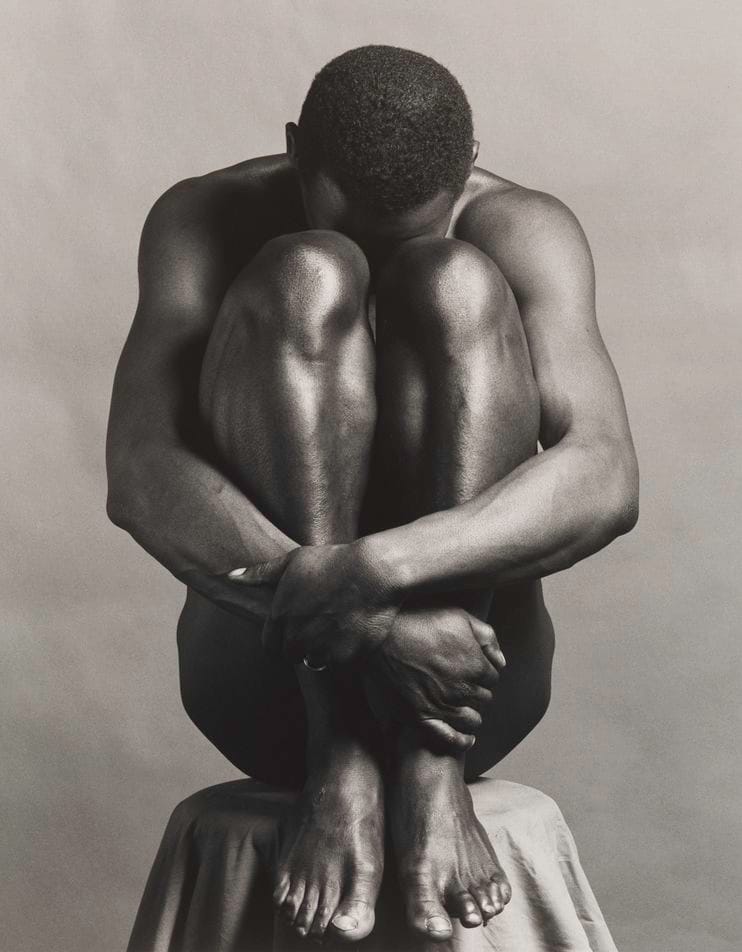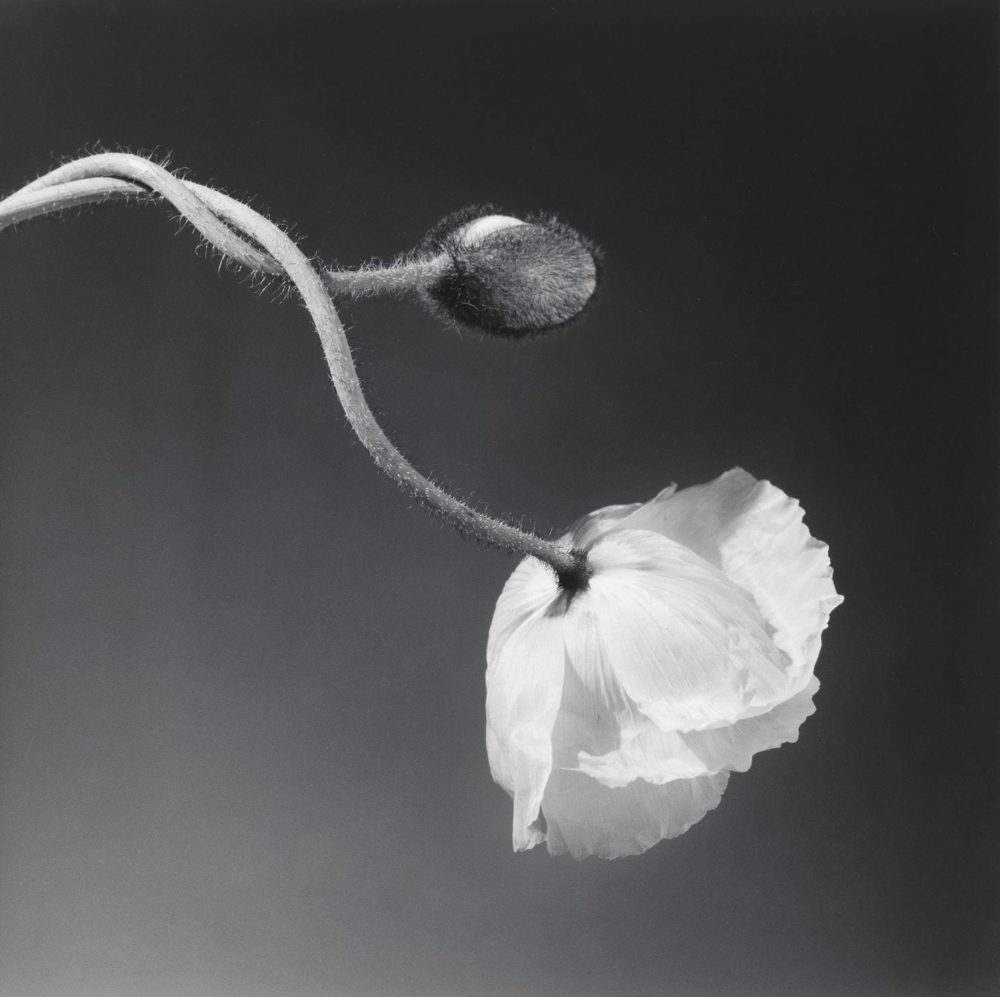
- Source: The Washington Post
- Author: Philip Kennicott
- Date: January 24, 2019
- Format: PRINT AND DIGITAL
Robert Mapplethorpe was one of the most controversial artists of the ’80s.
Now he looks entirely innocent.

Robert Mapplethorpe’s “Ajitto,” from 1981. (The Robert Mapplethorpe Foundation/Solomon R. Guggenheim Museum)
NEW YORK — Robert Mapplethorpe, whose photographs of naked African American men and ritualized scenes of sexual domination and bondage scandalized some Americans in the 1980s and ’90s, died 30 years ago this March at age 42. He is now a historic figure, an essential entry in any history of American art over the past half-century, a regular subject of exhibitions and retrospectives, and an increasingly legendary figure in the annals of the culture wars that still flare to life whenever political demagogues are imperiled by political head winds.
So today not only must we grapple with all the old problems presented by Mapplethorpe’s work — Does it objectify its subjects? Is it pornographic? Does it aestheticize transgressive sexuality for the consumption of elite art collectors? — but also reconsider all this in light of the simple fact that he belonged to a different world, removed from our own and governed by its own values and assumptions.
Audiences in New York can do just that in a powerful, compact survey of his work now at the Guggenheim Museum. “Implicit Tensions: Mapplethorpe Now” is the first of two Guggenheim exhibitions devoted to the artist this year (the second show, opening this summer, will look at the work of artists who admired Mapplethorpe, and others, such as Glenn Ligon, whose work looked critically at his legacy).
Using material given to the museum in 1993 by the Robert Mapplethorpe Foundation, curators Lauren Hinkson and Susan Thompson have covered all the essentials. The exhibition includes early collages and Polaroid self-portraits, images of the artist’s friends and colleagues, sculptural nudes, and flower still lifes, seen in sumptuous gelatin silver prints that make skin look like burnished metal and flowers like chiseled marble, capturing every trace of graffiti and abrasion in the plaster walls of an improvised sex dungeon. The show gives a powerful sense of both the ambition and the brevity of Mapplethorpe’s career, how quickly he moved from using the camera to discover sex to using it to construct an erotically charged world in which desire governs our relationship to people and things alike. And it reminds us how technically skilled he was, how his pursuit of perfection was often seen as his greatest provocation, and how he compelled us to look not just at things that made some people uncomfortable, but at a form of beauty that was both innocuous and titillating.

Robert Mapplethorpe, Self Portrait, 1980. Solomon R. Guggenheim Museum/Robert Mapplethorpe Foundation
Since Mapplethorpe’s 1978 self-portrait in which he sodomized himself with a bullwhip or his 1982 pristine still life of a disembodied African American penis, our understanding of sexuality has changed, from a discourse about exploration and liberation to a focus on the way sex is negotiated and the power relations inherent in the act. The shift hasn’t been absolute, and both conversations were going on then and to some extent now. But the urgency has moved, from a sense that sex is an anarchic form of self-discovery to a gathering collective idea that sex needs to be better governed, more equitable and disentangled from old ideas about patriarchy, power and the prerogatives of various kinds of privilege. Toxic masculinity isn’t just an academic concept, but the subject of a Gillette commercial, and intersectionality — the idea that we inhabit multiple identities and may suffer oppression in multiple ways unique to those different identities — is part of the zeitgeist, even if most people don’t use the word.
So what will audiences today make of work that, even when it was new, was criticized for objectifying African American men, disconnecting their selves, their minds, their emotional beings from their bodies, which were presented like ancient sculpture — fragmented, mute and idealized? At a moment when the necessary concern about sex is that it not be used to hurt people, how do we understand Mapplethorpe’s scenes of domination, like the trussed-up figure in the 1979 image “Dominick and Elliot,” in which one man is suspended upside down, naked, arms spread, like the crucifixion of Saint Peter?
When Mapplethorpe died of complications from AIDS in 1989, he was a successful artist, with commercial and art world cachet, but he wasn’t yet a household name. That would come about shortly after his death, when Washington’s Corcoran Museum cravenly gave in to powerful homophobes and canceled what had been a successful touring Mapplethorpe exhibition titled “The Perfect Moment.” Jesse Helms, the bigoted Republican senator from North Carolina, reviled Mapplethorpe and LGBT people in speeches from the Senate floor, extending a seamless skein of hate from the White House (where President George H.W. Bush blamed AIDS patients for their illness) to the general public, which was invited to imagine the worst in the images Helms took delight in describing. Mapplethorpe was caught up in what seemed like a debate about arts funding and censorship, but this was really a pretext for connecting sex to disease to a general sense of cultural decay — Helms called artists like Mapplethorpe “human cockroaches” — and blaming it all on LGBT people, a convenient minority scapegoat.

Robert Mapplethorpe’s “Poppy,” 1988. (Robert Mapplethorpe Foundation/Solomon R. Guggenheim Museum)
Today, the fear of AIDS has greatly diminished even if the disease is still a threat disproportionally felt in communities of color. The line between pornography and art is greatly more porous, the cultural stigma against pornography mostly a vestigial habit, and an adult film actress is among the best known and most articulate critics of a president who has boasted of sexual harassment and assault.
In this new age, Mapplethorpe’s photography feels strangely innocent, not just in the sense that it isn’t corrupt in the way its critics claimed, but also in a childlike way. One notices its playfulness, and humor, even in images that are as cold as black ice. Two stems intertwine in a late image titled “Poppy,” made in 1988, one a flower that droops under its own weight, the other a bud that is thrusting horizontally above, recalling millennia of flowers as a metaphor for body parts, desire and love.
In one of the great double portraits ever made, Philip Glass and Robert Wilson sit next to each other, divided by a line but so present in their personal magnetism that the line disappears. And one thinks: Two brilliant kids.
Four images of a model named Ajitto show a young African American man from all four sides, with the profile shots clearly recalling Hippolyte Flandrin’s popular 19th-century nude painting of a perfect youth by the seashore. But these two images are the ones that can’t be printed in the newspaper because they show the genitals, which are seen like shadows, and become something the eye chases in a way that makes the viewer feel, perhaps, that he has been pranked.
We don’t see Ajitto’s face, but we encounter the face of Ken Moody, a model whom Mapplethorpe photographed frequently. In one portrait, Moody’s eyes are closed, his skin luminous like some hard-stone Egyptian carving. The desire it arouses isn’t the desire to touch, which is held at bay by the resistant glossiness of the image, but rather, the desire to know. Far from alienating the subject from his inner life, the portrait suggests a rich, enticing and unknowable inner life, serenely closed up in a reliquary case of impenetrable skin.
The innocence of the photographer also is present, and casts later work in new light. An untitled self-portrait from 1973 uses six Polaroids to create a playful sense of Mapplethorpe’s sexual vulnerability and charisma and his fascination with classical statuary (seen in two central images), two strands that were entwined throughout his work. In two images made in 1977, for a double show that divided Mapplethorpe’s “respectable” work and his more sexual content between New York’s Holly Solomon Gallery and the edgier Kitchen space on Broome Street, there seems to be a simple duality: We see two hands, both holding a pen that has written the word “pictures,” with one hand emerging from the crisp cuff of a dress shirt and the other wearing a leather glove and a slightly menacing metal wrist band. But there’s another detail: The gloved hand that suggests the fetish side of Mapplethorpe’s persona has just lifted the pen from the paper, while the more proper hand is still writing. So, the artist tells us, the work isn’t done until the kink has dried.
Over the years, criticism of Mapplethorpe has often focused on ideas of authenticity, as if one Mapplethorpe was the true one and the other wasn’t. Was he an art-world dandy who used sexual imagery to boost his brand? Or was he using his exceptional technical skills to give pornography the sheen of high art? Neither was the case. Rather, Mapplethorpe seemed to see desire as inherently dignified and, as such, nothing to be confined to dark spaces or behind closed doors. A lovely portrait, from 1982, of Louise Bourgeois shows the great artist holding a large, nubbly phallus, one of her own sculptures. She is smiling and cradling it fondly in one arm. “I consider the masculine attributes to be very delicate,” Bourgeois once said. And she’s right, a delicacy seen throughout the work of Robert Mapplethorpe.
Implicit Tensions: Mapplethorpe Now Through July 10 at the Guggenheim Museum in New York. guggenheim.org.

